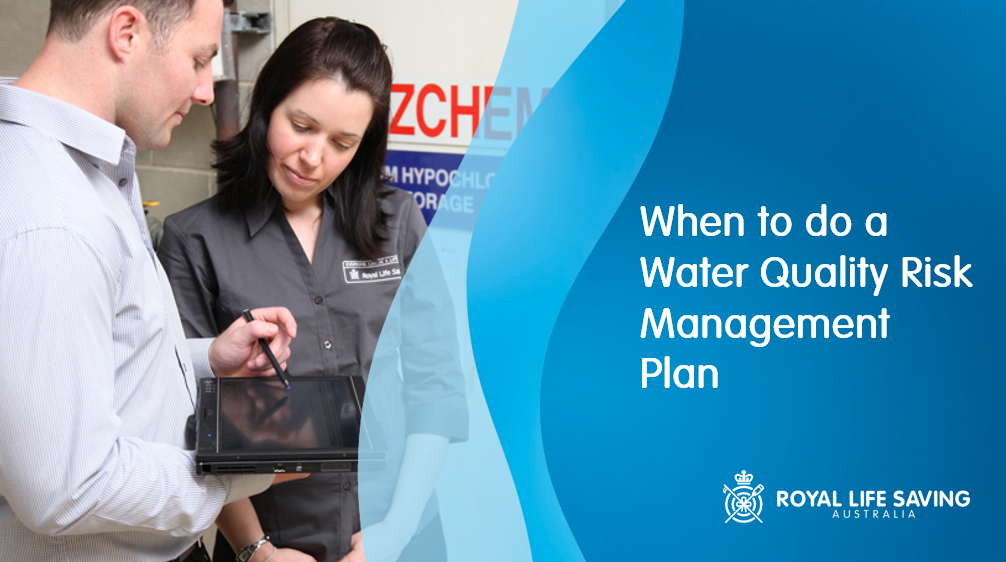Published 13th April 2022

When is it recommended to Develop Water Quality Risk Management Plan?
Depending on your State / Territory guidance, a Water Quality Risk Management Plan may be recommended under local guidelines and regulations.
Queensland
There are currently no Queensland Government laws for water quality at public aquatic facilities (pools, spas, water parks etc) although, under the Public Health Act 2005, a public aquatic facility must not pose a public health risk.
Under the Public Health Act 2005, local councils are responsible for the regulation of public aquatic facilities. Some councils have applied local laws to public aquatic facilities within their council area.
To clarify the requirements for operators of public aquatic facilities, Queensland Health has published Water Quality Guidelines for Public Aquatic Facilities (PDF 2363 kB).
These guidelines provide water quality criteria for public aquatic facilities and practical operational advice for facility operators. They also contain recommended response procedures for dealing with incidents such as faecal releases into a pool or remediating water that has been contaminated with Cryptosporidium.
To assist operators and managers of public aquatic facilities who need to develop a site-specific risk management plan, Queensland Health has also developed a Site-Specific Risk Management Plan template (DOCX 4658 kB).
While these guidelines were written for public aquatic facilities, many of the ideas within the guidelines can be applied to most types of pools, other than ‘natural’ or ‘chemical-free’ pools. As germs can contaminate any kind of pool, whether public or privately-operated, good hygiene and proactive pool management should be used for all pools.
Further pool hygiene resources:
For more information see: https://www.health.qld.gov.au/public-health/industry-environment/environment-land-water/water/quality/pool-spa-recreation
Northern Territory
The Northern Territory Public Health Guidelines for Aquatic Facilities recommend public aquatic facilities develop and implement risk management procedures, particularly in respect to the risk of Cryptosporidium outbreak.
In the Northern Territory, the legislation states that public swimming pools 'must be built and maintained to minimise risks to public health' with guidelines recommending the development of appropriate risk management procedures.
Victoria
In Victoria, the water quality guidelines reflect the aquatic facilities provisions of the Public Health and Wellbeing Regulations 2019, 'Regulation 46 - Duty to minimise risk' states:
"An aquatic facility operator must manage the risks to human health arising from pathogenic micro-organisms in the water in the aquatic facility in accordance with these Regulations and the Water Quality Guidelines."
Therefore, aquatic facilities that are covered by these regulations must follow the Water quality guidelines.
Section 1.3 of the 'Water quality guidelines' states that:
"All public aquatic facilities must have a water quality risk management plan in place to help minimise potential public health risks."
New South Wales
In New South Wales, similar Guidelines recommend a risk management plan be in place.
Australian Capital Territory
In the Australian Capital Territory, the Code of Practice to Minimise the Public health Risks from Swimming/Spa Pools does not explicitly require a Water Quality Risk Management Plan to be in place, although the Code requires strict adherence to its requirements.
Western Australia
In Western Australia, swimming pools are covered under a Public Health Code of Practice which recommends an operations manual and emergency action plan are in place.
South Australia
In South Australia, a The Standard for the Operation of Swimming Pools and Spa Pools specifies requirements to manage risk.
The standard states:
"Whilst the facility is available for use by the public it is the responsibility of the owner and the pool operator to ensure pool water quality is maintained in accordance with the requirements of the General Regulations."
and that:
"Failure to do so could result in legal proceedings being implemented for non-compliance."
Tasmania
In Tasmania, local government oversees water quality at public swimming pools and spas.
What is recommended?
Appropriate risk management is a consistent recommendation under most public health frameworks for public aquatic facilities, swimming pools, spas and commercial swimming pools.
Royal Life Saving recommends facility owners and operators comply with all local laws and to develop a Water Quality Risk Management Plan where this is recommended.
Water quality and risk management in inland waterways
The National Health and Medical Research Council is responsible for the Australian Guidelines for Managing Risks in Recreational Water. These guidelines provide a best-practice, hands-on, practical approach to help those managing recreational water quality. These guidelines are currently under review.
In addition, Royal Life Saving Society – Australia has developed draft Guidelines for Inland Waterway Safety which includes recommendations to check water quality at known swimming and aquatic recreation locations, particularly if delivering programs or services in the waterway, or are responsible for the health and safety of users of the waterway.
